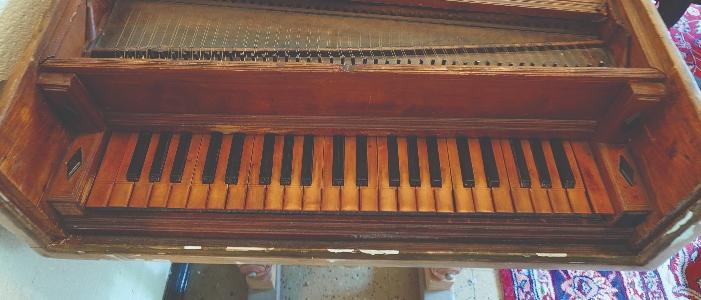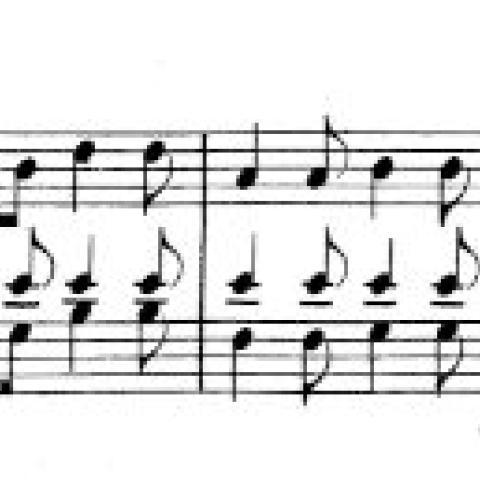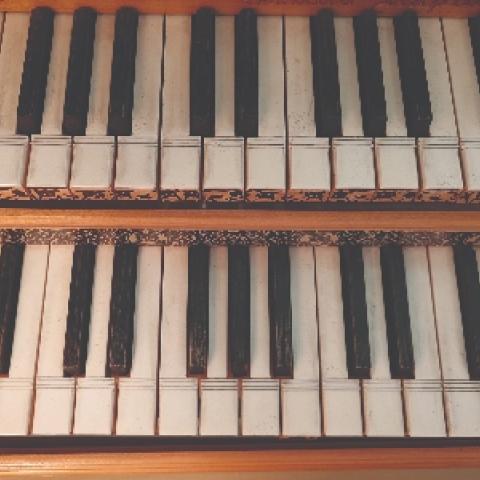
The harpsichord: an introduction, part 2
At the end of my previous column (August 2024, page 8), I noted that I would next turn my attention to a detailed discussion of harpsichord sonority. In thinking about that subject recently, I have realized that I should start by returning to the question of variety or non-standardization. This can affect our understanding of what is and is not a harpsichord, and what is or is not harpsichord sonority. Some of this variety is about setup—keyboards, stops, compass—and I will address these issues in my next column, including discussion of the mechanism of the harpsichord and what that implies about touch and technique. But some of the variety has to do with the sound itself.
Sound variety
It can be useful to think of sound variety as existing along two separate axes. For over 300 years, the harpsichord was the predominant domestic keyboard instrument, and its sounds varied from both region and historical period. Surviving antique instruments are one principal source of knowledge we have about different geographic schools of harpsichord sound and how that sound evolved over the years. Examples built in modern times along the lines of the older, original instruments are another source of information. There are all sorts of interesting complexities about the conclusions we can draw from any of these instruments. For example, it is difficult to ascertain how the sounds of existing antique instruments have changed over the years, and it is also difficult to know how successful the sound of a given modern instrument is in recreating the sound of the harpsichord as it was in the Baroque period, assuming the modern builder is trying to do that.
This brings us to the other axis along which harpsichords vary in their sonority. As the modern rediscovery of the harpsichord began in the very late nineteenth century and especially as it became popular in the early twentieth century and thereafter, harpsichord builders made different choices about how to approach the rediscovery or reinvention of this long-dormant instrument. No one building a harpsichord in modern times has been working from an ongoing, living tradition of instrument building. The arc of this learning process was and still is very long. Some of the choices that builders have made have been motivated specifically by concepts relating to sonority. For example, some harpsichord builders, especially in the mid-twentieth century, were interested in tackling questions about tuning stability and mechanical reliability in a world with central heating and air conditioning. The gist is that there are many harpsichords out there that reflect different stages in their builders’ learning processes, and that manifests different choices or preferences about harpsichord sound as well as mechanics.
Much has been written about this modern history. Since there are many very different-sounding instruments out there that are identified as harpsichords, two important concepts should be considered. First, that one should not assume that one’s concept of what a harpsichord “should” sound like is necessarily indicative of all harpsichords. Second, the best way to know what is going on with the sound of a given harpsichord is to listen to that sound carefully, closely, and with as few preconceptions as possible.
There are two traps that are easy to fall into. One of these is hearing a harpsichord whose sound you do not like and deciding that you do not like the harpsichord, and the other is getting attached to the sound of the first harpsichord that you hear and thereafter never listening open-mindedly to other sorts of harpsichords. The first of these was very common indeed in the mid-twentieth century when there were many harpsichords around that were experimental and largely unsuccessful. The second, interestingly, is a trap that I fell into early in my harpsichord life. I was lucky enough that the first harpsichord I ever owned and spent a lot of time with was an instrument with a compelling, gorgeous sound. At the time I did not think that I understood how strongly that instrument shaped my sense of what harpsichord should be and thereby limited my ability to appreciate many of the very different beautiful and effective sounds that were made by other harpsichords. I eventually coaxed myself out of this by increasingly remembering to pay attention.
What are some of the salient features of the sound of a harpsichord? What if anything is universal, what are common threads to look out for, what varies, and how can one best understand the sound of a given harpsichord with a view to using it most effectively?
For me the starting place is something that seems more technical than aesthetic, though in the end it is crucially about aesthetics and performance. The sound of each note on every harpsichord has an intrinsic behavior. From the instant the sound starts, from the moment when the plectrum lets go of the string, the sound does what it is going to do without any input from the player until it ends. This may be more purely true of harpsichord than of any other instrument. With violins, voices, flutes, etc., the performer can change a lot about the sound while performing; with plucked string instruments, there are measures of control, more or less subtle in nature, over ongoing notes that can be exercised by the player. Even with organ and piano there are some small such things: damper pedal actions that affect the overall sonority in a way that changes an existing sound picture; swell pedals; on some organs, manipulations of the wind during sustained notes by the playing of shorter notes. Nothing like any of this exists with the harpsichord. On almost all instruments, to some degree the player can at least partially create the sound; with harpsichord, the player works with a given sound. This sounds a bit inflexible, cold, and limited. And it could be if the sounds themselves were not extraordinary both in what they seem spontaneously to sound like and in what possibilities they create.
But if every harpsichord note has some sort of intrinsic behavior, that behavior is very different from one harpsichord to another. These differences pertain sometimes to the simple quality of sustaining. Interestingly, there is a tradition of believing that the harpsichord does not sustain as well or long as the piano. This is not necessarily true. It is true of some harpsichords, yet definitely not true of others. What is the shape of the first tiny fraction of a second of sound, the “attack?” Does the sound then die away in more or less a straight line or according to some other shape? Is the attack the loudest instant of the sound? Does the timbre of the sound remain constant as it dies away? Do all the partial tones die away at the same rate, or does the timbre change as the note grows quieter and eventually ceases to be heard?
Answers to these questions can be found on some harpsichords out there. The only way to answer the questions is to listen, and I will discuss some listening techniques here, as well as ways to think about relating this analysis of the sound to playing music. There are some generalizations that are interesting and helpful if we remember that they might not always apply. Surviving, well-restored harpsichords from the sixteenth through eighteenth centuries tend to share certain acoustic traits, offering similar answers to the questions above and to other questions about acoustics. They tend to have a crisp attack—not all according to exactly the same pattern, and not necessarily loud, but all with immediacy and clarity, often seeming either bell-like or “plucky.” They tend to sustain longer than we sometimes expect with a harpsichord, long enough that in most music, all but the longest notes are vividly present for as long as they are notated. The issue of harpsichord notes dying away so promptly that they do not fill the space allotted is a false problem, at least on instruments of this sort. On many older instruments, the sound dies away not in straight line, but in gentle but perceptible waves, which create a subtle pulse to the sound. At the same time, the sound also changes in timbre over the length of the note.
There are two concrete and compelling effects that the above combination of traits has on the ways in which sonority relates to playing music. The first has to do with tempo and timing. If the sound has an intrinsic pulse to it, that exists in relation to time as such and is not created, shaped, or determined by the rhythmic picture of a piece being played. That means that since choices about tempo are also choices about how much of the lifespan of each note to use, those choices affect what the actual shape of the notes will be. A shorter note is not just shorter. Since it also uses a smaller part of the lifespan of each note, it has a different shape from what a longer note would have had. For example, if there is going to be a peak of a (gentle) wave 0.6 seconds after the beginning of a note, then if your tempo for that note is 120, you will never get to that peak; if your tempo is 90, you will.
On an instrument with a sound such as this, one can record a passage at two different tempos and then use computer magic to adjust them to being at the same tempo as each other, and they will not actually sound the same. The sonority-scape will be very clearly different.
The second effect concerns the relationships among notes that are occurring at the same time. If there are longer and shorter notes happening in juxtaposition to one another, then the longer notes will be heard more prominently while the quicker notes are going by. This is like the situation in a choral piece where one section has longer notes—and the conductor reminds the singers to do something through the duration of those notes: something as active, if subtle, with volume, timbre, vibrato, or whatever else. This can keep the effect of those longer notes from being static or from dragging down the momentum of the music. The intrinsic sound of a harpsichord can serve this same purpose to similar effect. This is one reason that the presence of lots of long notes in a keyboard piece does not necessarily mean that it should be performed on an organ rather than a harpsichord. The organ can sustain long notes indefinitely, but those sounds can also defeat momentum in a way that the sound of a harpsichord never does.
Everything from the last few paragraphs is just one set of possible examples of what one might hear in the sound of a harpsichord. The overall points are: one can tell by careful listening what the sound of a given harpsichord is like, especially in that it is largely set and does not change in performance; and what one hears in the sound may well have implications for performance choices and for how the instrument is likely to come across in performance.
There are some points that are more straightforward and that are common to just about all harpsichords. One of these is that when there are two 8′ stops, they differ from each other in timbre. Inevitably, one stop is flutier and one reedier: one gedeckt-like, one with at least a bit of the quintadena about it. (I will discuss this further in my next column, as it arises out of the mechanism and physical setup of a harpsichord.) Each individual stop tends to change in timbre from bottom to top: reedier at the bottom, flutier at the top. This also arises out of the physical setup.
Getting to know a harpsichord
I recommend the following as a set of starting points for getting to know a new harpsichord. First, move the music desk out of the way, as it blocks much of the sound from the player’s ears. (This is especially true in a wing-shaped harpsichord, less true with virginals, spinets, and upright harpsichords.) Make sure there is only one stop on, and know which one it is. Then play some individual notes, starting in the middle of the compass, moving up and down. One might do some of this standing up and leaning out over the soundboard. Hold notes for a long time, and listen to the whole span of the length of each note. Then play some bits of scales, chords, and perhaps passages from pieces. If possible, have someone else play while listening. One should start near the curve in the side of the instrument and then move out a bit farther along that same line. Slower pieces are better for this sort of close listening than faster pieces. Faster pieces certainly demonstrate some of what the instrument can do, but give you less of a direct line to what the sonority is like. When listening to someone else play, one should be slightly less analytical than what I am describing. Are you reacting to the sound as beautiful, compelling, loud enough that you do not have to strain, so loud that it is annoying, such a pleasure that you are reluctant to ask your colleague to stop and go back to playing yourself? All of these could well happen along with an infinite number of other reactions.
Next, go back and play some individual notes on each stop. Do you hear them at all differently now from when you did the same thing a few minutes before? What is the last thing that you hear before a note has fully died away: it might be an overtone; the answer might be different for different notes. The next step is to play a passage, trying to focus on listening to different parts of the texture: lowest notes, highest notes, and most importantly, notes in the inner part of the texture.
Try to do this with as few preconceptions as possible. Do some of the above with your eyes closed. This can help focus on listening, but it can also help banish preconceptions. Since there are interconnections between mechanical aspects of the harpsichord and sonority, I will continue to build on these ideas next time.





